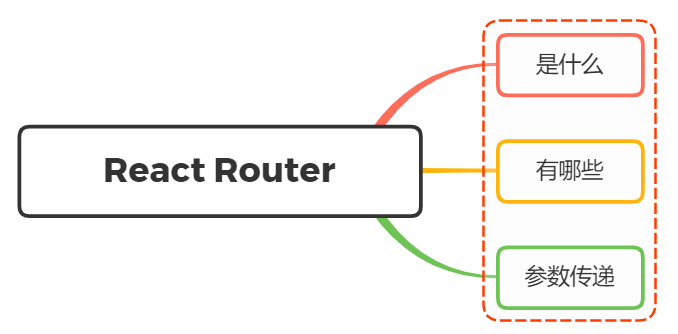# 面试官:说说你对React Router的理解?常用的Router组件有哪些?

# 一、是什么
react-router等前端路由的原理大致相同,可以实现无刷新的条件下切换显示不同的页面
路由的本质就是页面的URL发生改变时,页面的显示结果可以根据URL的变化而变化,但是页面不会刷新
因此,可以通过前端路由可以实现单页(SPA)应用
react-router主要分成了几个不同的包:
react-router: 实现了路由的核心功能
react-router-dom: 基于 react-router,加入了在浏览器运行环境下的一些功能
react-router-native:基于 react-router,加入了 react-native 运行环境下的一些功能
react-router-config: 用于配置静态路由的工具库
# 二、有哪些
这里主要讲述的是react-router-dom的常用API,主要是提供了一些组件:
- BrowserRouter、HashRouter
- Route
- Link、NavLink
- switch
- redirect
# BrowserRouter、HashRouter
Router中包含了对路径改变的监听,并且会将相应的路径传递给子组件
BrowserRouter是history模式,HashRouter模式
使用两者作为最顶层组件包裹其他组件
import { BrowserRouter as Router } from "react-router-dom";
export default function App() {
return (
<Router>
<main>
<nav>
<ul>
<li>
< a href=" ">Home</ a>
</li>
<li>
< a href="/about">About</ a>
</li>
<li>
< a href="/contact">Contact</ a>
</li>
</ul>
</nav>
</main>
</Router>
);
}
2
3
4
5
6
7
8
9
10
11
12
13
14
15
16
17
18
19
20
21
22
23
# Route
Route用于路径的匹配,然后进行组件的渲染,对应的属性如下:
- path 属性:用于设置匹配到的路径
- component 属性:设置匹配到路径后,渲染的组件
- render 属性:设置匹配到路径后,渲染的内容
- exact 属性:开启精准匹配,只有精准匹配到完全一致的路径,才会渲染对应的组件
import { BrowserRouter as Router, Route } from "react-router-dom";
export default function App() {
return (
<Router>
<main>
<nav>
<ul>
<li>
< a href="/">Home</ a>
</li>
<li>
< a href="/about">About</ a>
</li>
<li>
< a href="/contact">Contact</ a>
</li>
</ul>
</nav>
<Route path="/" render={() => <h1>Welcome!</h1>} />
</main>
</Router>
);
}
2
3
4
5
6
7
8
9
10
11
12
13
14
15
16
17
18
19
20
21
22
23
24
# Link、NavLink
通常路径的跳转是使用Link组件,最终会被渲染成a元素,其中属性to代替a标题的href属性
NavLink是在Link基础之上增加了一些样式属性,例如组件被选中时,发生样式变化,则可以设置NavLink的一下属性:
- activeStyle:活跃时(匹配时)的样式
- activeClassName:活跃时添加的class
如下:
<NavLink to="/" exact activeStyle={{color: "red"}}>首页</NavLink>
<NavLink to="/about" activeStyle={{color: "red"}}>关于</NavLink>
<NavLink to="/profile" activeStyle={{color: "red"}}>我的</NavLink>
2
3
如果需要实现js实现页面的跳转,那么可以通过下面的形式:
通过Route作为顶层组件包裹其他组件后,页面组件就可以接收到一些路由相关的东西,比如props.history
const Contact = ({ history }) => (
<Fragment>
<h1>Contact</h1>
<button onClick={() => history.push("/")}>Go to home</button>
<FakeText />
</Fragment>
);
2
3
4
5
6
7
props中接收到的history对象具有一些方便的方法,如goBack,goForward,push
# redirect
用于路由的重定向,当这个组件出现时,就会执行跳转到对应的to路径中,如下例子:
const About = ({
match: {
params: { name },
},
}) => (
// props.match.params.name
<Fragment>
{name !== "tom" ? <Redirect to="/" /> : null}
<h1>About {name}</h1>
<FakeText />
</Fragment>
)
2
3
4
5
6
7
8
9
10
11
12
上述组件当接收到的路由参数name 不等于 tom 的时候,将会自动重定向到首页
# switch
swich组件的作用适用于当匹配到第一个组件的时候,后面的组件就不应该继续匹配
如下例子:
<Switch>
<Route exact path="/" component={Home} />
<Route path="/about" component={About} />
<Route path="/profile" component={Profile} />
<Route path="/:userid" component={User} />
<Route component={NoMatch} />
</Switch>
2
3
4
5
6
7
如果不使用switch组件进行包裹
除了一些路由相关的组件之外,react-router还提供一些hooks,如下:
- useHistory
- useParams
- useLocation
# useHistory
useHistory可以让组件内部直接访问history,无须通过props获取
import { useHistory } from "react-router-dom";
const Contact = () => {
const history = useHistory();
return (
<Fragment>
<h1>Contact</h1>
<button onClick={() => history.push("/")}>Go to home</button>
</Fragment>
);
};
2
3
4
5
6
7
8
9
10
11
# useParams
const About = () => {
const { name } = useParams();
return (
// props.match.params.name
<Fragment>
{name !== "John Doe" ? <Redirect to="/" /> : null}
<h1>About {name}</h1>
<Route component={Contact} />
</Fragment>
);
};
2
3
4
5
6
7
8
9
10
11
# useLocation
useLocation 会返回当前 URL的 location对象
import { useLocation } from "react-router-dom";
const Contact = () => {
const { pathname } = useLocation();
return (
<Fragment>
<h1>Contact</h1>
<p>Current URL: {pathname}</p >
</Fragment>
);
};
2
3
4
5
6
7
8
9
10
11
12
# 三、参数传递
这些路由传递参数主要分成了三种形式:
- 动态路由的方式
- search传递参数
- to传入对象
# 动态路由
动态路由的概念指的是路由中的路径并不会固定
例如将path在Route匹配时写成/detail/:id,那么 /detail/abc、/detail/123都可以匹配到该Route
<NavLink to="/detail/abc123">详情</NavLink>
<Switch>
... 其他Route
<Route path="/detail/:id" component={Detail}/>
<Route component={NoMatch} />
</Switch>
2
3
4
5
6
7
获取参数方式如下:
console.log(props.match.params.xxx)
# search传递参数
在跳转的路径中添加了一些query参数;
<NavLink to="/detail2?name=why&age=18">详情2</NavLink>
<Switch>
<Route path="/detail2" component={Detail2}/>
</Switch>
2
3
4
5
获取形式如下:
console.log(props.location.search)
# to传入对象
传递方式如下:
<NavLink to={{
pathname: "/detail2",
query: {name: "kobe", age: 30},
state: {height: 1.98, address: "洛杉矶"},
search: "?apikey=123"
}}>
详情2
</NavLink>
2
3
4
5
6
7
8
获取参数的形式如下:
console.log(props.location)
# 参考文献
- http://react-guide.github.io/react-router-cn/docs/API.html#route
